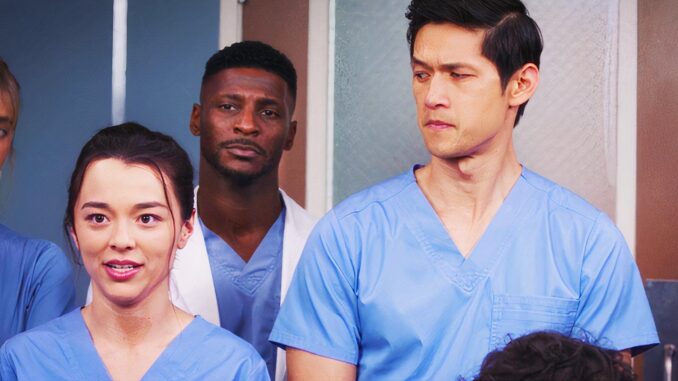
Kwan arrived at Grey Sloan Memorial a sharpened blade of intellect, gleaming with textbook knowledge and an almost clinical precision. He’d aced every theoretical exam, dissected cadavers with flawless technique, and believed wholeheartedly in the power of protocols and algorithms. The human body, in his mind, was a meticulously engineered machine, predictable and, with enough skill and study, conquerable. Grey Sloan, however, wasn't just a hospital; it was a crucible, a relentless, often brutal forge where the brittle steel of academic ambition was hammered into something infinitely more resilient and, crucially, more human. What Grey Sloan taught Kwan wasn't merely surgical technique or diagnostic acumen; it taught him about the messy, vulnerable, profoundly interconnected being he truly was.
His first humbling lesson arrived not in the sterile, predictable environment of the OR, but in the chaos of an E.R. trauma bay. Kwan, the brilliant intern who could rattle off rare syndromes, found himself paralyzed as a patient coded, the frantic beeping of the monitor a jarring counterpoint to the attending's calm, decisive commands. His mind, accustomed to linear problem-solving, buckled under the weight of simultaneous variables: the rapidly dropping sats, the irregular rhythm, the mother’s desperate pleas. He saw, for the first time, that knowledge without instinct, compassion without action, was inert. In that moment, watching the attending, Dr. Miranda Bailey, move with a fierce, practiced grace, Kwan understood that courage wasn’t the absence of fear, but the decision to act despite it. He learned that his meticulous preparation was merely a foundation, and on top of it, life demanded improvisation, resilience, and an unflinching willingness to get his hands dirty, literally and figuratively. He saw the tremor in his own hands, the flush on his face, and realized he wasn’t just a brain; he was a collection of nerves, fear, and a nascent, fierce desire to help.
Then came the inevitable, soul-crushing encounters with loss. Kwan had approached patient death academically – a failure of treatment, a biological endpoint. But Grey Sloan forced him to confront it as a raw, personal tragedy. He remembered Mrs. Henderson, a sweet, elderly woman whose heart, despite every intervention, simply gave out. Kwan had diligently monitored her, reviewed her charts, and even found himself sharing quiet jokes with her. When the flatline came, it wasn't just a clinical pronouncement; it was the sudden, shattering silence of a life extinguished. He watched her grieving daughter, the way the hospital chaplain spoke, and the quiet dignity with which the nurses prepared the body. He felt a tightness in his chest he couldn’t name, a grief that wasn't his own, yet was undeniably real. Grey Sloan taught him that detachment was a dangerous illusion, and that true healing—for both patient and doctor—involved acknowledging the emotional landscape of suffering and death. He saw his attendings grieve, argue, celebrate, and break down, and understood that their strength lay not in being impervious, but in their capacity to feel, process, and still show up the next day. He learned that his capacity for empathy, which he had once considered a distraction, was in fact his most powerful diagnostic tool.
Finally, Grey Sloan stripped away his illusion of self-sufficiency. Kwan had always been a lone wolf, trusting his own intellect above all else. But in the high-stakes dance of the operating room, he found himself utterly dependent on the scrub nurse who anticipated his next move, the anesthesiologist who kept the patient stable, the resident who held the retractors just so. He watched surgeons defer to specialists, admit when they didn't know, and trust their teams implicitly. He recalled a complex multi-trauma case where he, as the primary resident, had to coordinate with neurosurgery, orthopedics, and plastics, his every decision reliant on the expertise and communication of others. It was an intricate ballet of trust, vulnerability, and shared purpose. He learned that brilliance, isolated, was brittle; brilliance, collaborative, was unbreakable. He saw his own impatience, his occasional arrogance, reflect back at him in the frustrated looks of his peers, forcing him to check his ego and truly listen, truly share the burden. He learned that his greatest strength wasn't his individual capacity, but his ability to connect, to lead, and crucially, to be led.
Kwan left Grey Sloan Memorial a different kind of surgeon, and more importantly, a different kind of human. The gleaming blade of intellect was still sharp, but it was now tempered by compassion, etched with humility, and bound by the invisible threads of human connection. He understood that medicine wasn't about conquering the body, but about honoring its fragility and its resilience. He knew that courage wasn't about suppressing fear, but about moving through it. And he realized that his own self, once perceived as a standalone entity, was irrevocably intertwined with the lives he touched, the colleagues he trusted, and the relentless, beautiful chaos of Grey Sloan Memorial. It had stripped him bare, but in doing so, it had revealed the true contours of his own humanity, a discovery far more profound than any medical breakthrough.
